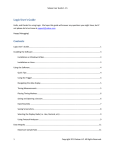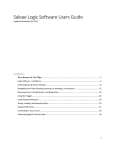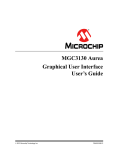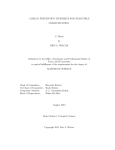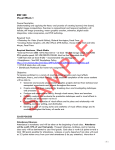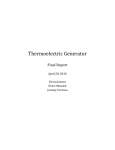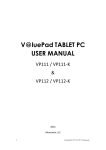Download Logic & Logic16 User's Guide Contents
Transcript
Saleae User Guide 1.1.15 Logic&Logic16User’sGuide Hello, and thanks for using Logic. We hope this guide will answer any questions you might have, but if not please do let us know at [email protected] Warning: Using Logic or Logic16 to test equipment powered by AC MAINs power can be hazardous to equipment. Battery‐powered, wall‐wart powered, and USB powered equipment is generally safe. For anything else please make sure to read the section Safety and Equipment Protection. Happy Debugging! Contents Logic & Logic16 User’s Guide ........................................................................................................................ 1 Installing the Software .................................................................................................................................. 3 Installation on Windows & Mac ............................................................................................................ 3 Installation on Linux .............................................................................................................................. 3 Using the Hardware ...................................................................................................................................... 4 Connecting the wire harness ................................................................................................................ 4 Logic16 Wire harnesses ........................................................................................................................ 4 Test Clips ............................................................................................................................................... 4 Connecting directly to IDE headers ....................................................................................................... 4 Disconnect Logic from your circuit when the USB is unplugged .......................................................... 4 Safety and Equipment Protection ......................................................................................................... 4 Using the Software ........................................................................................................................................ 6 Quick Tips .............................................................................................................................................. 6 Using the Trigger ................................................................................................................................... 6 Navigating the data display ................................................................................................................... 6 1 Copyright 2012 Saleae LLC. All Rights Reserved. Saleae User Guide 1.1.15 Timing Measurements .......................................................................................................................... 7 Placing Timing Markers ......................................................................................................................... 8 Saving and Opening a Session ............................................................................................................... 8 Exporting Data ...................................................................................................................................... 8 Saving Screenshots.............................................................................................................................. 10 Selecting the Display Radix (i.e. Hex, Decimal, etc.) ........................................................................... 10 Using Protocol Analyzers .................................................................................................................... 11 Hiding, un‐hiding, and reordering channels ....................................................................................... 12 Resetting the trigger, channel names, channel ordering and channel visibility ................................. 12 Hiding the channel labels and/or trigger ............................................................................................ 13 Working with tabs ............................................................................................................................... 13 Switching between multiple Saleae logic analyzers ........................................................................... 15 Changing the Logic16 channels ........................................................................................................... 16 Crosstalk (and Logic16 input voltage selection) ................................................................................. 17 Saleae Community Site ............................................................................................................................... 19 SDKs – Device SDK and Analyzer SDK .................................................................................................. 19 Forum .................................................................................................................................................. 19 Beta software releases ........................................................................................................................ 19 Data Integrity .............................................................................................................................................. 20 Maximum Sample Rate ....................................................................................................................... 20 Maximum sample rate, and long captures – Logic16 ......................................................................... 21 Safety and Equipment Protection ............................................................................................................... 22 Contacting Us .............................................................................................................................................. 23 2 Copyright 2012 Saleae LLC. All Rights Reserved. Saleae User Guide 1.1.15 InstallingtheSoftware InstallationonWindows&Mac Download the latest version from our site, here: http://www.saleae.com/downloads. Double click & install like any other application. Note: Windows XP Users: Please download the 32‐bit version of the software. Note: Vista & Windows 7 Users: Please download the either 32‐bit or 64‐bit installation depending on your version of Windows. You can find out by right‐clicking Computer in the start menu, and choosing Properties. OS X Tiger Users: The application needs to be unzipped before it can be installed. InstallationonLinux 1. Download the latest version from our site, here: here: http://www.saleae.com/downloads. 2. There is no installer, you can unzip the application anywhere you like, perhaps your home folder, or your desktop. You can start using it on your desktop, and move it later if you like. 3. Double click the Logic executable to start the program. 4. If you like, make a link to the Logic application for your desktop or application menu or dock. 5. Note that wherever you decide to put the logic application, it must all stay together in the same folder structure, and it must have write permissions. 6. When connecting to Logic, you may get a message from the application that it doesn’t have permissions to connect to Logic. If this happens, run the install_driver script in the application’s Driver folder. 32‐bit vs. 64‐bit: Please choose the version appropriate for your Linux Distribution. 64‐bit Users: Please note that as of 1.1.5, you won’t be able to load sessions saved with other versions (platform distributions) of the Logic software. However, other Logic software distributions will be able to load sessions that you save. Sorry for the trouble – we’ll get this fixed. 3 Copyright 2012 Saleae LLC. All Rights Reserved. Saleae User Guide 1.1.15 UsingtheHardware Connectingthewireharness To determine the correct way of attaching the wire harness, look on the back of your device for the ground symbol: Then find the gray wire on the wire harness. This is the ground wire. It will have a GROUND label near its end: Logic16Wireharnesses Logic16 uses two 9‐wire harnesses. On the bottom of the device, these are labeled A and B. A is channels 0‐7, and B is channels 8‐15. Note that you don’t need to have both harnesses plugged in if you’re only using the first 8 channels. TestClips You can connect your test leads (from the wire harness) to the provided test clips. They might require quite a bit of force before they “click.” ConnectingdirectlytoIDEheaders In some situations, you will be able to plug the test leads directly into IDE headers on your PCB, which can be very convenient. For new PCB designs, we recommend including headers for things you might need to look at during firmware development. You only need to solder in the headers if you have an issue, and they can be removed in the final PCB revisions if needed. These will serve as nice test points for an oscilloscope as well. Don’t forget to wire in some ground pins as well. DisconnectLogicfromyourcircuitwhentheUSBisunplugged You should disconnect Logic from your circuit when it is not connected to your computer. If Logic is not powered by the USB, it can put a load on your circuit that can compromise signal integrity. SafetyandEquipmentProtection In general, Logic and Logic16 may not be used with DUTs (devices under test) which are not electrically isolated from MAINs (wall power). This is because the logic analyzer shares a common ground with your computer, which typically is grounded with respect to MAINs earth ground. This creates a potential 4 Copyright 2012 Saleae LLC. All Rights Reserved. Saleae User Guide 1.1.15 short circuit path for any non‐isolated MAINs‐derived voltages, via the logic analyzer’s ground input(s). For more details, please refer to the section on Safety and Equipment Protection near the end of this User’s Guide. 5 Copyright 2012 Saleae LLC. All Rights Reserved. Saleae User Guide 1.1.15 UsingtheSoftware QuickTips Almost everything has tooltips that offer some explanation of what it does. Most functions have keyboard shortcuts, described in their menu item or their tool tip. UsingtheTrigger Tip: mouse‐over the trigger buttons for a description. The trigger looks for a single edge. To use the trigger, there must be one edge specified. You can also specify that other inputs must be in particular states (high or low) when the edge occurs. Pre‐trigger data will be collected for the region of time before the trigger is found (to the extent the trigger is not immediately found). You can configure this amount under Options ‐ >Preferences The time where the trigger is found is time zero in the display. Navigatingthedatadisplay Click and drag the display to move it 6 Copyright 2012 Saleae LLC. All Rights Reserved. Saleae User Guide 1.1.15 Use the scroll wheel on your mouse to zoom in and out Alternatively, use the arrow keys to zoom and pan (The +/‐ keys also zoom) To “jump to next,” move your mouse to, and click the button that will appear near at the ends of the graphs. You can use the keys N (next) and P (previous) as well. (this applies to the channel that was last used by the mouse) TimingMeasurements Tip: Move your mouse over each measurement label for a description. Width: The time between the selected two successive signal transitions. Period: The time elapsed between the selected three successive signal transitions. Frequency: The frequency computed by dividing one (1) by the time elapsed between the selected three successive signal transitions. Duty Cycle: The % of time the signal is high (1) during the selected three successive signal transitions. Byte: The numerical representation of all 8 channels combined into one byte, at the specified location. T1: The absolute time specified by the location of the T1 timing marker. T2: The absolute time specified by the location of the T2 timing marker. | T1 ‐ T2 |: The time elapsed between the timing markers. To show or hide particular measurements, use the settings button. 7 Copyright 2012 Saleae LLC. All Rights Reserved. Saleae User Guide 1.1.15 PlacingTimingMarkers Single‐click the T1 or T2 label. (or use 1 and 2 keys on your keyboard) Move your mouse to the desired location. Note that you can still pan and zoom. Single click to place the marker. Your mouse must not be moving when you place the marker. To move the marker after it has been placed, click it. To cancel placing a marker, right‐click or press the escape key. SavingandOpeningaSession To save a session that includes data, press CTRL‐S (CMD‐S on a Mac) or select this function from the Options menu. To save a session that contains only settings, press CTRL‐SHIFT‐S (CMD‐SHIFT‐S on a Mac), or select this function from the Options menu. To open a session of any type, drag it into the software, or press CTRL‐O (CMD‐O on a Mac), or select this function from the Options menu. ExportingData To export data, select Options‐>Export Data (CTRL‐E). 8 Copyright 2012 Saleae LLC. All Rights Reserved. Saleae User Guide 1.1.15 Channels to Export: Select which channels you would like to export Samples to Export: Select the time period over which you would like to export samples o Tip: If you are using timing markers, you can export just the data between them. This option will only appear in the list if two timing markers have already been placed. Export Format – Binary o o 9 You can select if you want data outputted for every sample, or only for samples that are different than prior samples. Note that if you export only changes in the data, a 64‐bit sample number is written before each sample in the file. If you aren’t exporting all of the channels, you can choose to leave the bits in their original channel locations, or to have them shifted right to fill any unused positions. Copyright 2012 Saleae LLC. All Rights Reserved. Saleae User Guide 1.1.15 o You can choose to export each sample as an 8, 16, 32, or 64‐bit word. Export Format – VCD o VCD stands for Value Change Dump, and is a common format for digital data. Export Format – CSV o o o o o Choose this format to export data as comma or tab delimited, human readable text. You can optionally include column headings for the data You can use sample number (i.e. 1, 2, 3, 4) or timestamps (i.e. .00123s ) to specify the time a sample represents. This occupies the first column. You can combine all the channels into a single number, or you can export each bit in its own column. You can export every sample, or only samples that have changed. SavingScreenshots You can take a screenshot of all or part of the application, and either save it to a file, or copy it to the clipboard. You can find this in the Options menu, or use the keyboard shortcuts. SelectingtheDisplayRadix(i.e.Hex,Decimal,etc.) Use this Options menu item (or the keyboard shortcuts) to quickly toggle between the different display modes. 10 Copyright 2012 Saleae LLC. All Rights Reserved. Saleae User Guide 1.1.15 UsingProtocolAnalyzers To add a protocol analyzer, select one from the menu in the Analyzers panel. Protocol analyzers can share inputs with other analyzers. This can be useful in some cases, such as SPI. After you add (or edit) an analyzer, it immediate runs against any data you have collected. To export data from an analyzer, press the small file icon next to it. (Center button). 11 If you need to change the display format (radix) of a particular analyzer, you can do this from the Analyzer settings menu. Copyright 2012 Saleae LLC. All Rights Reserved. Saleae User Guide 1.1.15 Hiding,un‐hiding,andreorderingchannels You can hide channels you aren’t using. (Note that this is different than turning off channels – which you can do with Logic16 to increase sampling speed) Move your mouse over the channel label area of the screen. I drop down menu button will appear. You can Hide channels, Show (un‐hide) them, and Move (reorder) them. Resettingthetrigger,channelnames,channelorderingandchannelvisibility Sometimes you may want to start from a fresh slate, and you don’t want to do this one item at a time. Use the Reset option to do this. 12 Copyright 2012 Saleae LLC. All Rights Reserved. Saleae User Guide 1.1.15 Hidingthechannellabelsand/ortrigger To clear up additional screen space, you can optionally hide both the channel label and/or the trigger. Find this under the Options menu item. Workingwithtabs Tabs let you save multiple captures, and switch between them. TheCaptureTab The most important thing to know is that you can only capture new data from the Capture tab, which is the small tab with the magnifying glass logo. 13 Copyright 2012 Saleae LLC. All Rights Reserved. Saleae User Guide 1.1.15 Addingnewtabs After you collect data, the Capture Tab will change, adding a button to one side. Click this button to move your new data into its own tab. Renamingatab Click tab’s text to edit it. Note that a tab must be active before it can be edited. Press enter, or click outside the text area to stop editing. Reorderingtabs You can reorder tabs however you like, by dragging them. 14 Copyright 2012 Saleae LLC. All Rights Reserved. Saleae User Guide 1.1.15 ClosingTabs You can close tabs by using its menu. This can’t be undone, so be sure to save your session if you need to, before closing the tab. Copyingsettingsbetweentabs Occasionally you may make changes on one tab you may wish to propagate to another tab. From the tab’s menu, choose Copy. For instance, if you set up some analyzers in one tab, and you wanted to run them against data in a different tab, you could copy them. Note that this will replace any analyzers that were already in that tab. Tabs,andsavingyourdata When you save your session, (Options‐>Save Session‐>settings & data) you are only saving the session associated with the currently active tab. There isn’t a way (yet) to save all your tabs at the same time, or to save them all to a single file – a “session set”. We will be adding this capability in the future. SwitchingbetweenmultipleSaleaelogicanalyzers While there isn’t a way to collect from multiple Saleae logic analyzers at the same time, you can have more than one connected to your computer, which can be helpful in some circumstances. If more than one logic analyzer is connected, the menu item Connected Devices item will appear in the Options menu. 15 Copyright 2012 Saleae LLC. All Rights Reserved. Saleae User Guide 1.1.15 ChangingtheLogic16channels With Logic16 you can select which channels to use – and if you need fewer channels you can sample at higher speeds. This setting is in the Options menu, under Logic16 channels. You can select from one of the standard options, or be more specific by choosing Select custom channels. 16 Copyright 2012 Saleae LLC. All Rights Reserved. Saleae User Guide 1.1.15 Crosstalk(andLogic16inputvoltageselection) Logic16 has two voltage settings, one for 1.8V to 3.6V, and another for 3.6V to 5V. The lower voltage settings should work in most circumstances. The 5V setting is provided to reduce the likelihood of channel to channel crosstalk when using 5V signals. Crosstalk is developed, at least in part, by Logic16’s long lead wires, fast rise/fall times, and is greatest when using 5V signals. Logic16’s front end filters noise like this, but only up to a point. You should be able to have 8 different signals simultaneously switch without seeing crosstalk on adjacent signals. 17 Copyright 2012 Saleae LLC. All Rights Reserved. Saleae User Guide 1.1.15 If you experience crosstalk, be sure both ground wires are connected to your circuit as this can make a dramatic difference. Unconnected (floating) inputs are much more susceptible to crosstalk. You may want to turn off or hide unused signals. This applies to both Logic and Logic16. 18 Copyright 2012 Saleae LLC. All Rights Reserved. Saleae User Guide 1.1.15 SaleaeCommunitySite SDKs–DeviceSDKandAnalyzerSDK We have cross‐platform, c++ based SDKs for getting access to Logic or Logic16 at a low level, and for making your own protocol analyzer plugins. You can get access to this SDK at our community site, at saleae.com/community. Forum To share ideas or issues, and to connect with other users, head over to the forum in the community site, at saleae.com/community. Betasoftwarereleases We occasionally have new software releases which we think are pretty good, but don’t want to risk disrupting a large number of users if something in it needs fixing. Typically these releases turn out to be pretty stable and have additional features and fixes that the current release doesn’t have. If there are any beta releases, they’ll be on the community site. 19 Copyright 2012 Saleae LLC. All Rights Reserved. Saleae User Guide 1.1.15 DataIntegrity Logic and Logic16 may not be able to achieve a particular sample rate (see the next sections) but it will never present data with samples missing. By design it stops and notifies you as soon as any data is lost. MaximumSampleRate Generally speaking Logic is able to achieve sample rates of 24MHz when no other devices are on the USB host, and your computer is responding sufficiently quickly. However if the USB is servicing other devices, or the computer is performing in a latent manner, a smaller sample rate, such as 16MHz or 12MHz may be the fastest achievable. The reason for this is as follows: Logic uses USB 2.0, and uses the USB transfer type known as “Bulk”. While this transfer type has the largest theoretical average bandwidth (significantly larger even than the 24 MB/s needed by Logic) it also has the lowest priority. This means it may be “bumped” for other USB traffic from other devices. The second issue is that Logic has very limited device‐side memory. Specifically it has x4 512 byte buffers. These buffers must be emptied by the USB in such a way that they never all become full at the same time. If this happens, the logic software will report that the sample rate could not be maintained. This means that even if on average (which would normally be the case) the USB can give Logic at least 24 MB/s, it must not prioritize other devices on the USB for so much time that Logic’s small buffer would overflow. For this reason Logic can’t guarantee that it will operate at its maximum 24MHz, as this is contingent on a number of factors including computer performance, USB bandwidth availability and latency, other drivers that may be using the USB, etc. To maximize the sample rate possible on your computer, try the following: 20 Make sure that no other applications are consuming significant CPU time. Make sure you have enough free RAM so that the OS will not have swap ram to the hard drive. This will be too slow. Try connecting Logic directly to your computer instead of through a USB hub. Make sure other devices on the USB are minimally active. (i.e. not webcams, hard drives, etc.) Try disconnecting other peripherals from the USB, or switching Logic to a port serviced by a different host controller. You may even want to try a dedicated host controller, such as this one http://www.newegg.com/Product/Product.aspx?Item=N82E16815166014 Increase the process priority of the Logic software. o Windows: From the Windows Task Manager, select the Processes tab, and find the Logic process. Right click on this item and select Set Priority ‐> High. o Linux: From the command line, navigate to the folder where the Logic executable is. Type nice –n 3 ./Logic. Search for Linux nice on Google for more information. Copyright 2012 Saleae LLC. All Rights Reserved. Saleae User Guide 1.1.15 Maximumsamplerate,andlongcaptures–Logic16 Logic16 has a significantly larger hardware‐side buffer than Logic, and therefore is much more immune to latencies in the USB. It is also more likely than Logic to reliably operate at its maximum speed on a given computer. If you need to capture for long periods of time, especially to catch “overnight” errors in the act, we recommend using Logic16. 21 Copyright 2012 Saleae LLC. All Rights Reserved. Saleae User Guide 1.1.15 SafetyandEquipmentProtection The primary concern for safety and equipment protection is the ground return path. Logic’s (and Logic16’s) ground input is essentially shorted to the ground of your computer, and your computer’s ground is likely connected to earth ground. Therefore Logic’s ground line has the potential to provide a high current ground return path to a device under test. This can result in the destruction of Logic, the USB host, and in the worst case, the computer. Logic should not be used with DUTs (devices under test) which are not electrically isolated from MAINS (i.e. wall power). There is one exception outlined below, but it comes with important caveats and must be fully understood. Please contact us if you have any concerns. o If you need to test a MAINs–connected DUT, one possible solution is to use a Laptop, running on battery power and not connected to anything else (such as a likely‐grounded LCD monitor). This will prevent Logic from providing a short circuit ground return path. HOWEVER – this setup introduces an additional and very serious safety concern. The reason for the MAINs earth ground connection in the first place it to prevent a high voltage from connecting to a chassis which could cause electric shock to a user. A grounded chassis, if connected to a large voltage, will provide a short circuit, which then blows a circuit breaker or fuse and removes the high voltage, protecting a user from potential electrocution. If you use the workaround presented here, you must ensure that it is impossible for any high voltage to be connected to any of Logic’s inputs, and especially Logic’s ground lead. Low voltages (as measured relative to earth ground) – which would not present a risk of electric shock – are permissible. o Isolation transformers, such as those made by Tripp‐lite: These transformers provide a large 1:1 transformer so that that the “hot” AC power lines are electrically isolated from MAINS. However, and crucially, they DO NOT isolate the MAINs earth ground connection, and so are not useful for providing a solution to this issue. DUTs which are battery powered, or USB powered (from the same computer as Logic) are acceptable. o When using USB powered DUTs, special care should be taken to avoid connecting USB sourced power to Logic's ground, as this provides a short‐circuit return path. DUTs powered by AC adapters which have only 2 prongs, and do not have an earth ground connection (such as most "wall warts") usually provide MAINS isolated power and are generally acceptable. They also are less likely to be able to source enough current to cause serious destruction. We highly recommending testing for good isolation. o If in any doubt as to if Logic’s ground ‐‐ and/or the ground of your DUT ‐‐ is isolated from MAINs earth ground, use a Multimeter to measure the resistance to earth ground. At this time, there are no cost effective isolation products for 480Mbit USB (High Speed USB) that we are aware of. There are fiber optic based solutions that cost around $1000. 22 Copyright 2012 Saleae LLC. All Rights Reserved. Saleae User Guide 1.1.15 ContactingUs You’re always welcome to contact us about anything. [email protected] is typically the best way to reach us, or online at http://www.saleae.com/contact We’re more than happy to discuss any issue or questions you have via phone, too. The most reliable time to reach us is in the afternoons and early evening (Pacific time). If you miss us, please do leave a message and we’ll call you back. 510‐984‐2463 23 Copyright 2012 Saleae LLC. All Rights Reserved.























